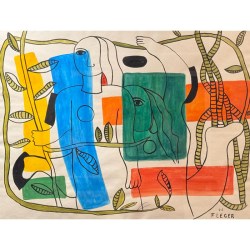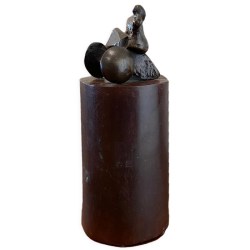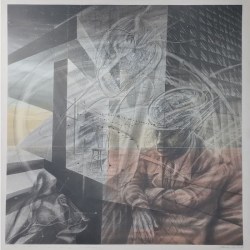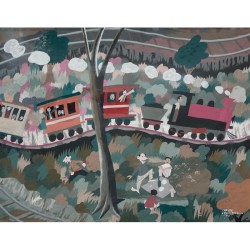Text by Federica Palomero

It has been insisted, and rightly so, on the traditional character of the sculpture of Varela, and the artist himself has explained himself in this regard on several occasions. "I made my choice and I try to express it in a contemporary manner without considering art as a matter of breaks." It is easy to recognize his identifying with tradition as one of the merits of his work: its relationship with the millenary bronze technique, with the eternal theme of women, with the intrinsic values of the sculpting endeavor.
In fact, a study of his work could be based on this membership, which is also important for the Venezuelan art, rare in major contributions to figurative bronze pieces. But it is also necessary to continue forward to glimpse in Varela the contemporary artist who, while leaning on this legacy, -which he does firmly-, upsets it from within at almost all levels.
His unswerving loyalty is to the technique: practically the same as from ancient Sumer and Egypt. There is something deeply moving about this insistence, the stubbornness of the artisan who does not deviate from his job, knowledge and skills, who feels that this membershiplegitimizes and supports him, especially against a quite often alien context, not to mention hostile to that meaning of doing, creating, to embody the concept in the matter.
In contrast, at the same instant Varela reaffirms in the matter a traditional sculptural value, he belies it and replaces it, or adjacent to it, another value. This attitude is not accommodating and requires from the artist constant questioning and reformulation, from art history and from his own work. Varela flees from certainties and statements, and ends setting with the medium which he so reveres a relationship fraught with ambiguity.
The incessant dialectic between balance and imbalance between shape and volume, mass and lightness, statism and movement is only one aspect of this relationship. An essential aspect, of course, because it is a symbolic testimony to the eternal struggle against the sculptor's materials, his existential need to negotiate and create with them, respecting their needs and limitations, all the while taking them to where he wants them to be, the support without which the concept does not take shape.
Moreover, as a result of the above, that freedom of the artist that does not conform to the alleged physical limitations of his medium, there is in the work of Abigail Varela an abstract accent that seems to want to deny the claim, in the first instance final, that his work is figurative. With its distortions, its elliptical character and synthetic, their very presence in space, his characters draw almost abstract figures, in any case divorced from mimesis; or it is his abstract forms which acquire human form. (Both views are complementary). The constant transition, with the resulting instability between the plane and volume, transforms the human body in a pure plastic matter, malleable at the whim of the artist, in which the external references become diluted.
The contours are resolved in broad lines in which the few straight lines and numerous curves are detached from the human form and acquire their own pace. The volumes also become independent. This is how some of Varela’s works seem to evoke the abstract forms of a Calder, and the surrealist liberties of a Miró. One extended leg becomes an autonomous dialogue between a cylindrical volume and a curved one: “Sitting crying to Heaven II”, 1995.
In less conventional pose sculptures there is a growing tendency to abstraction, since these by themselves stray from known figurative models. This is the case of “Female walker traveling”, 1990; “Woman with ball”, same year; “Syncretic Totem”, 1993; “Woman with ball II”, 1997. And, ultimately, the process of deformation of the body, which is never aggressive despite its radicalism, and which that makes these women are only possible in Varela’s sculpture, becomes a process of abstraction as it moves away from the real female body as well as naturalistic sculptures. This process, faced with the occasional introduction of almost hyper-realistic detail (a suitcase, a box) is then reinforced by contrast, incidentally providing a humorous tone. The contrast can become one of the possible readings of a much more complex work than might appear at first glance, thanks to its cheerful, sensual and hedonistic aspects.
Although very accurate and categorized influences are not identifyable, with undisputed scientific certainty, much less pure and unique, but melted and syncretic, there exist in all of Abigail Varela’s works some recognizable references, already mentioned, from prehistoric and primitive figures, to the statuary of ancient Greece and modern tradition. Cross references, which generally, also refer to the zeitgeist of the late twentieth century, that freedom of artists who enjoy not wanting to stand out by being original but rather retake of others, past or present, everything that might be useful to, by virtue of mixing, interpretation and metamorphosis, build their own language, which in turn others will take as a starting point and so on.
Also, in the order of reinterpretations, Varela has a preference for those echoes of the archaic, as reflected in near-mask faces, closed and expressionless, with a prominent nose, which draws with the arch of the eyebrows a stylized line, sunken eyes and thick lips.
The artist belongs thus to the "tradition of the primitive" which starts with the twentieth century which in sculpture will mark artists such as Constantin Brancusi and Henry Moore. It is not uncommon to find a certain family resemblance between some heads sculpted by Henry Moore and those of Varela, as the English sculptor sought inspiration in pre-Columbian carvings and ceramics.
But, on the other hand, Varela rejects conclusively his stativism. And then returns to the great tradition of classical Greek and Hellenistic, -denial of all early-type aesthetics-, so that his sculptures become animated as if by the breath of life.
And at the same time, he diverges from the concept of beauty per the Greek ideal, to suggest shapes reminiscent of other styles, -from prehistoric times to the modern expressionism-, in which that search is not involved. However, it is not so easy to ignore, when one creates female body sculpture, the ghosts of centuries in which they were associated, so obvious and never put into question, with Beauty capitalized. Varela, however, is not concerned, as it is no longer of concern to most contemporary artists. In this sense Henry Moore said: "Beauty in the sense of classical Greece or the Renaissance, is not my purpose. There is a functional difference between the beauty of expression and the force of expression. The first aims at to please, the second tends to a spiritual vitality that is for me more emotional and deeper." Words to which Abigail Varela could subscribe. But all this does not stop this beauty so neglected and abandoned to resurface when least expected, perhaps when the artist least expects it, as if out of his hands, but of not his intentions.
Beauty is not subject to the ideal, let alone what is real. It may be born out of the vitality that sustents each of its pieces, even the most serene-. And while Varela is not among the artists who leave on their finished work marks of the sculpture process, on the contrary, he specially takes care of the finish so that on it only the sensuality of the sculpture-woman skin becomes apparent, translating in other ways, more subtle, hidden and ethereal, totally fused with the matter of his work, the heartbeat of Creation.
Federica Palomero l August 2000








